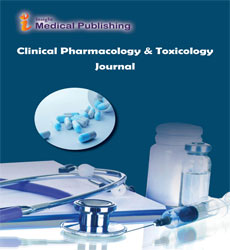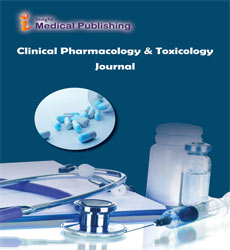Mechanisms of Drug-Induced Hepatotoxicity: Clinical Perspectives
*Corresponding author:
Clöwy Baldwina,
Department of Drugs, Institute for Maternal and Child Health-IRCCS “Burlo Garofolo”, Via dell’Istria 65/1, 34137 Trieste, Italy,
E-mail: Baldwina.clowy@burlo.trieste.it
Received date: February 01, 2025, Manuscript No. iprrt-25-20705; Editor assigned date: February 03, 2025, PreQC No. iprrt-25-20705 (PQ); Reviewed date: February 15, 2025, QC No. iprrt-25-20705; Revised date: February 22, 2025, Manuscript No. iprrt-25-20705 (R); Published date: February 28, 2025
Citation: Baldwina C (2025) Mechanisms of Drug-Induced Hepatotoxicity: Clinical Perspectives. Clin Phar Toxi Jour Vol.09 No.1:04
Introduction
Drug-Induced Hepatotoxicity (DIH) is a significant clinical concern, representing one of the leading causes of acute liver failure and drug withdrawal from the market. The liver, as the central organ for drug metabolism and detoxification, is particularly vulnerable to chemical insults. Hepatotoxicity can arise from prescription medications, over-the-counter drugs, herbal supplements and environmental chemicals. It manifests as a wide spectrum of liver injury, including hepatocellular damage, cholestasis, steatosis, fibrosis and in severe cases, fulminant hepatic failure. Understanding the mechanisms underlying Drug-Induced Liver Injury (DILI) is crucial for early diagnosis, risk stratification and therapeutic intervention. Advances in molecular biology, pharmacogenomics and clinical research have elucidated multiple pathways of hepatotoxicity, offering insights into prevention, monitoring and personalized management strategies [1].
Description
Drug-induced hepatotoxicity can result from intrinsic or idiosyncratic mechanisms. Intrinsic hepatotoxicity is predictable, dose-dependent and occurs shortly after exposure. Acetaminophen overdose exemplifies intrinsic hepatotoxicity, where excessive doses saturate the liverâ??s detoxification pathways, leading to accumulation of the reactive metabolite N-Acetyl-P-Benzoquinone Imine (NAPQI). NAPQI depletes glutathione reserves and binds to cellular proteins, inducing oxidative stress, mitochondrial dysfunction and hepatocyte necrosis [2]. The dose-dependent nature of intrinsic hepatotoxicity allows for preventive strategies, including patient education, dose monitoring and early intervention with antidotes such as N-acetylcysteine. Idiosyncratic hepatotoxicity is unpredictable, dose-independent and occurs in a small subset of patients. It is often immune-mediated or metabolic in origin. Immune-mediated DILI involves the activation of adaptive immune responses against hepatocytes. Drugs or their reactive metabolites act as haptens, modifying cellular proteins and triggering T-cell mediated cytotoxicity. This mechanism is exemplified by reactions to halothane, amoxicillin-clavulanate and certain anticonvulsants. Genetic predisposition, including specific Human Leukocyte Antigen (HLA) alleles, increases susceptibility, highlighting the role of pharmacogenomics in risk assessment [1].
Metabolic idiosyncratic hepatotoxicity arises from the formation of reactive metabolites or intermediates that overwhelm hepatocyte defense systems. Cytochrome P450 enzymes metabolize drugs into reactive species capable of covalently binding to proteins, lipids, or nucleic acids, initiating oxidative stress, mitochondrial injury and endoplasmic reticulum stress. These processes disrupt cellular homeostasis, leading to apoptosis or necrosis. Examples include hepatotoxicity caused by isoniazid, diclofenac and troglitazone. The interplay between metabolic pathways, antioxidant capacity and mitochondrial resilience determines the extent of liver injury.
Mitochondrial dysfunction is a central mechanism in drug-induced hepatotoxicity. Many hepatotoxic drugs impair mitochondrial respiration, decrease ATP production and generate excessive Reactive Oxygen Species (ROS). Accumulation of ROS triggers lipid peroxidation, DNA damage and activation of apoptotic pathways. Drugs such as valproic acid, amiodarone and certain antiretroviral agents demonstrate mitochondrial toxicity, resulting in steatosis, microvesicular fat accumulation, or liver failure. Mitochondrial impairment also sensitizes hepatocytes to secondary insults, compounding injury and clinical severity. Cholestatic injury, characterized by impaired bile formation or flow, is another manifestation of drug-induced hepatotoxicity.
Drugs such as chlorpromazine, anabolic steroids and certain antibiotics interfere with bile transporters, including the Bile Salt Export Pump (BSEP) and Multidrug Resistance-Associated Proteins (MRPs). Accumulation of bile acids induces hepatocyte apoptosis, inflammation and fibrosis. Clinically, cholestatic DILI presents with jaundice, pruritus and elevated serum alkaline phosphatase, requiring careful monitoring and cessation of the offending agent.
Oxidative stress and inflammation are intertwined mechanisms contributing to hepatotoxicity. Reactive metabolites, mitochondrial ROS and cytokine-mediated responses amplify hepatocyte injury. Kupffer cells, the liver-resident macrophages, release pro-inflammatory cytokines such as Tumor Necrosis Factor-Alpha (TNF-α) and interleukins in response to cellular damage, recruiting immune cells and exacerbating inflammation. Persistent oxidative and inflammatory stress can progress to chronic liver injury, fibrosis, or cirrhosis. Pharmacogenomic insights have enhanced understanding of susceptibility to DILI. Genetic polymorphisms in drug-metabolizing enzymes (CYP450 variants), transporters and HLA alleles influence drug bioactivation, detoxification and immune recognition. For example, HLA-B*57:01 is associated with flucloxacillin-induced liver injury, while HLA-A 33:01 increases risk with terbinafine. Screening for high-risk alleles can guide therapy, prevent severe hepatotoxicity and enable personalized medicine approaches.
Conclusion
Drug-induced hepatotoxicity remains a major clinical concern, with mechanisms involving intrinsic toxicity, idiosyncratic reactions, metabolic activation, mitochondrial dysfunction, oxidative stress and immune-mediated injury. Understanding these pathways informs risk assessment, early detection and individualized management strategies. Pharmacogenomics provides insights into patient susceptibility, enabling personalized therapy and prevention of severe outcomes. Clinically, careful monitoring of liver function, prompt discontinuation of offending agents and supportive care are essential to optimizing patient safety. Advances in molecular and clinical research continue to elucidate the complex mechanisms of DILI, offering prospects for improved predictive models, targeted interventions and safer therapeutic strategies. Through these efforts, clinicians can better balance therapeutic benefits with hepatotoxic risk, ensuring safer pharmacotherapy and improved patient outcomes.
Acknowledgement
None.
Conflict of Interest
None.
References
- Haya, K (1989) Toxicity of pyrethroid insecticides to fish. Environ Toxicol Chemis 8: 381-391.
- Elliott, M (1976) Properties and applications of pyrethroids. Environ Hlth Perspect 14: 1-2.
Google Scholar Cross Ref Indexed at

Open Access Journals
- Aquaculture & Veterinary Science
- Chemistry & Chemical Sciences
- Clinical Sciences
- Engineering
- General Science
- Genetics & Molecular Biology
- Health Care & Nursing
- Immunology & Microbiology
- Materials Science
- Mathematics & Physics
- Medical Sciences
- Neurology & Psychiatry
- Oncology & Cancer Science
- Pharmaceutical Sciences
